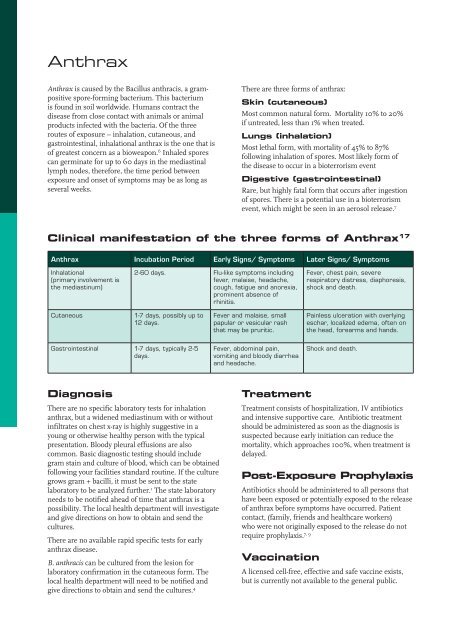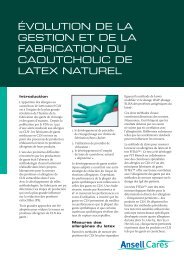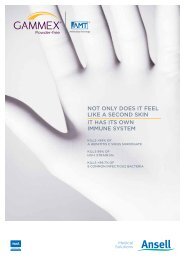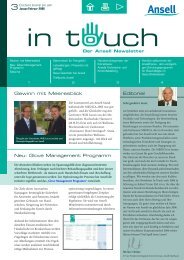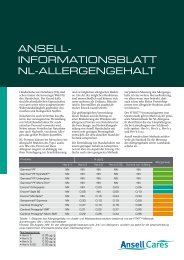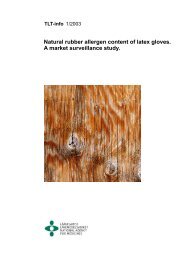Download full document (pdf) - Ansell Healthcare Europe
Download full document (pdf) - Ansell Healthcare Europe
Download full document (pdf) - Ansell Healthcare Europe
Create successful ePaper yourself
Turn your PDF publications into a flip-book with our unique Google optimized e-Paper software.
Anthrax<br />
Anthrax is caused by the Bacillus anthracis, a grampositive<br />
spore-forming bacterium. This bacterium<br />
is found in soil worldwide. Humans contract the<br />
disease from close contact with animals or animal<br />
products infected with the bacteria. Of the three<br />
routes of exposure – inhalation, cutaneous, and<br />
gastrointestinal, inhalational anthrax is the one that is<br />
of greatest concern as a bioweapon. 6 Inhaled spores<br />
can germinate for up to 60 days in the mediastinal<br />
lymph nodes, therefore, the time period between<br />
exposure and onset of symptoms may be as long as<br />
several weeks.<br />
There are three forms of anthrax:<br />
Skin (cutaneous)<br />
Most common natural form. Mortality 10% to 20%<br />
if untreated, less than 1% when treated.<br />
Lungs (inhalation)<br />
Most lethal form, with mortality of 45% to 87%<br />
following inhalation of spores. Most likely form of<br />
the disease to occur in a bioterrorism event<br />
Digestive (gastrointestinal)<br />
Rare, but highly fatal form that occurs after ingestion<br />
of spores. There is a potential use in a bioterrorism<br />
event, which might be seen in an aerosol release. 7<br />
Clinical manifestation of the three forms of Anthrax 17<br />
Anthrax Incubation Period Early Signs/ Symptoms Later Signs/ Symptoms<br />
Inhalational<br />
(primary involvement is<br />
the mediastinum)<br />
Cutaneous 1-7 days, possibly up to<br />
12 days.<br />
Gastrointestinal 1-7 days, typically 2-5<br />
days.<br />
Diagnosis<br />
2-60 days. Flu-like symptoms including<br />
fever, malaise, headache,<br />
cough, fatigue and anorexia,<br />
prominent absence of<br />
rhinitis.<br />
There are no specific laboratory tests for inhalation<br />
anthrax, but a widened mediastinum with or without<br />
infiltrates on chest x-ray is highly suggestive in a<br />
young or otherwise healthy person with the typical<br />
presentation. Bloody pleural effusions are also<br />
common. Basic diagnostic testing should include<br />
gram stain and culture of blood, which can be obtained<br />
following your facilities standard routine. If the culture<br />
grows gram + bacilli, it must be sent to the state<br />
laboratory to be analyzed further. 1 The state laboratory<br />
needs to be notified ahead of time that anthrax is a<br />
possibility. The local health department will investigate<br />
and give directions on how to obtain and send the<br />
cultures.<br />
There are no available rapid specific tests for early<br />
anthrax disease.<br />
B. anthracis can be cultured from the lesion for<br />
laboratory confirmation in the cutaneous form. The<br />
local health department will need to be notified and<br />
give directions to obtain and send the cultures. 4<br />
Fever and malaise, small<br />
papular or vesicular rash<br />
that may be pruritic.<br />
Fever, abdominal pain,<br />
vomiting and bloody diarrhea<br />
and headache.<br />
Treatment<br />
Fever, chest pain, severe<br />
respiratory distress, diaphoresis,<br />
shock and death.<br />
Painless ulceration with overlying<br />
eschar, localized edema, often on<br />
the head, forearms and hands.<br />
Shock and death.<br />
Treatment consists of hospitalization, IV antibiotics<br />
and intensive supportive care. Antibiotic treatment<br />
should be administered as soon as the diagnosis is<br />
suspected because early initiation can reduce the<br />
mortality, which approaches 100%, when treatment is<br />
delayed.<br />
Post-Exposure Prophylaxis<br />
Antibiotics should be administered to all persons that<br />
have been exposed or potentially exposed to the release<br />
of anthrax before symptoms have occurred. Patient<br />
contact, (family, friends and healthcare workers)<br />
who were not originally exposed to the release do not<br />
7, 9<br />
require prophylaxis.<br />
Vaccination<br />
A licensed cell-free, effective and safe vaccine exists,<br />
but is currently not available to the general public.


